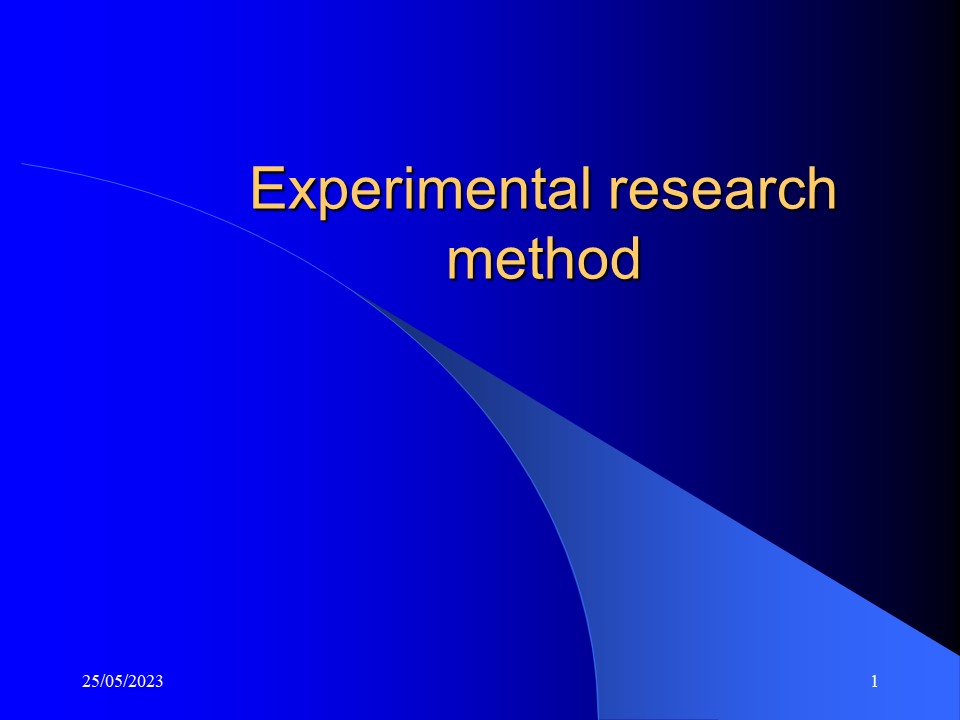Experimental Research - PowerPoint PPT Presentation
Title:
Experimental Research
Description:
psychology – PowerPoint PPT presentation
Number of Views:0
Title: Experimental Research
1
Experimental research method
2
Experimental method
- Experimental research is a comparison-between-
groups. - The experimenters are seeking to discover cause
and effect relationships by changing something to
see if the change causes a difference to another
thing. - They alter the independent variable (IV) to see
if it causes a difference to a dependent
variable (DV).
3
- A Classic, experimental method involves assigning
subjects at random to either an experimental
group or a control group. - The control group is compared with the
experimental group to assess the effects of the
experiment on the experimental group.
4
Switching on the light
- The independent variable(IV) can be likened to a
light switch and the dependent variable (DV) can
be likened to a light bulb. - An experiment compares the results of exposure of
one (independent) variable upon another (the
dependent variable). - Switch on (the IV switch) and the (DV) bulb
(metaphorically) illuminates the room.
5
Advantages of experimental research methods
- The experiment is probably the best scientific
method for attempting to find causal
relationships. - It allows us to locate the variables which
control or cause a problem to occur. - For some researchers such as those in the
physical sciences the experiment has good
internal validity because of the degree to which
all extraneous variables are controlled.
6
Aims of experimental research
- Establish cause and effect relationships.
- Then, like a switch we can turn the phenomena
on and off. - This is useful as the ability to switch things on
or off means, a) we can be reasonably confident
weve found variables that cause or impact on the
problem significantly, and b) we can use that
knowledge to control or adjust such phenomena. - Such knowledge has advanced natural science and
medicine as mentioned.
7
Issues in any experimental research
- Internal validity--This is summed up in the
following question -Does the experiment test what
we say it tests? - How sure can we be that the changes in the DV we
measured were caused by the changes in the IV? - Are all extraneous variables or confounding
variables (ie one which changes as IV changes)
controlled?
8
- External validity means how strong are the
generalizations we can make from this research
(if any)?
9
Threats to validity of experiments
- Internal validity threats
- History mediating event or factor between pre-
and post-test alternative possible explanation
of effects. History refers to events that occur
between the DV measurements in a repeated
measures design
10
More threats to internal validity of experiments
- Maturation refers to systematic changes in
participants physiology or psychology that occur
over time during an experiment - E.g. fatigue, boredom
- Testing The effect of taking a first test upon a
second or subsequent test - measuring the DV causes a change in the DV.
- If your attention is being explicitly measured,
you may be more attentive than you would be
otherwise
11
Even more threats
- Instrumentation
- Instrumental bias or instrumental decay
- Changes in a measuring instrument that occur over
time - Behavioral observations most susceptible
- Observers may become more skilled or fatigued
- refers to the experience and familiarity of the
participant with test taking.
12
Yet other threats
- Selection bias If we choose participants in such
a way that our groups are not equal before the
experiment, we cannot be certain that our IV
caused any difference we observe after the
experiment. - Mortality/Attrition Loss of people from
comparison groups ( they die, they move, they get
new jobs etc).
13
Threats to Internal Validity
- Diffusion or Imitation of Treatments- can occur
if participants in one treatment group become
familiar with the treatment of another group and
copy that treatment. - Carry-over effects
- Specific treatments cause changes in the next
treatment(s) and alter the participants score - NOTE caused by experiencing a SPECIFIC treatment
14
- Carryover effects
- are challenging for within-subjects research
designs, that is, when the same participants are
exposed to all experimental treatments and
results are compared across different treatments.
These designs are useful, among other reasons,
because they allow a near perfect match of
subject characteristics as the researcher
compares measurements of the same participant.
However, as the same subjects are used in all
experimental treatments, there is a possibility
that a previous treatment can alter behaviour in
a subsequent experimental treatment. This is
known as a carryover effect. - One type of carryover effect is a practice effect
, where participants perform a task better in
later conditions because they have had a chance
to practice it.
15
Threats to External Validity
- Generality across Response Measures
- E.g. Physiological versus behavioral measures of
a phobia treatment can affect one but not the
other
16
Social science experimentsExamples
- Asch(1955)-Opinion social pressure
- Milgram (1964)-Obedience to authority
- Zimbardo(1974)-psychology of imprisonment
17
(No Transcript)































